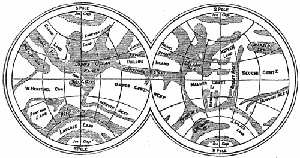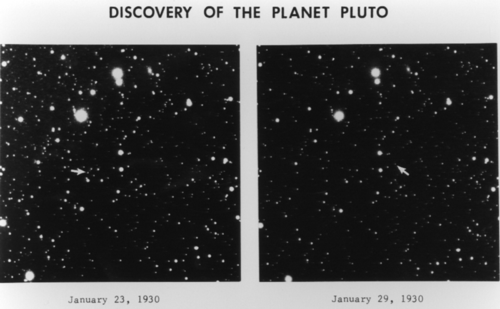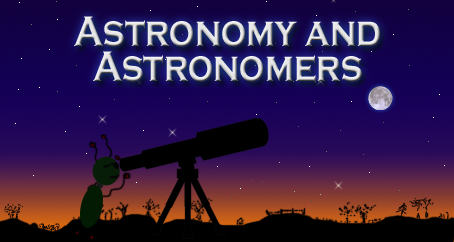Modern Astronomy

During the Twentieth Century, astronomy began to be combined with space exploration. Up to the middle of the century, just about everything we knew about the universe was based on what could be seen from Earth. The earliest astronomers could only use their eyes and, although they were obviously able to see stars that are billions of miles away from Earth, they were only able to look as far as Saturn when observing the Solar System. After the invention of the telescope in the Seventeenth Century, it became possible to look further into space and during the centuries that followed, Uranus and Neptune were discovered and moons were found in orbit of most planets. Detailed maps could be made of the side of the Moon visible from Earth. The surface of Mars was also mapped, even though the maps later turned out to be mostly inaccurate!
The early part of the Twentieth Century brought about more discoveries. Telescopes continued to get stronger and more moons were discovered orbiting the giant planets. Himalia and Elara were discovered around Jupiter in 1904 and 1905 respectively and Phoebe had been discovered around Saturn in 1899 (ok, it's not the Twentieth Century, but it's close!). However, perhaps the biggest discovery was the discovery of Pluto. Astronomers suspected that Neptune wasn't the most distant object in the Solar System. Earlier astronomers had had a similar suspicion when they observed Uranus. Believing that something more distant was having an influence on Uranus' orbit, they calculated the position of another planet and found Neptune in 1846. Suspecting an object more distant than Neptune, in 1906, Percival Lovell, astronomer at the Lowell Observatory in Flagstaff, Arizona, began the search for "Planet X". He died in 1916 having failed to discover his planet. Quite unfortunately, it had been imaged at his observatory in 1915 but wasn't noticed. After his death, the search for Planet X wasn't resumed until 1929 when Clyde Tombaugh was given the task of taking and observing images of regions of space taken on different days. If any object exists in these regions that is not a star, then it would appear in a different place in the two images when they are compared, as if it had moved. On 18th February 1930, Tombaugh finally came across two images, taken on 23rd and 29th January 1930, which contained an object in different positions (shown below). A third image taken on 21st January, showed the same object, but again in a different position. This confirmed that he had found Lowell's Planet X. The object later became known as Pluto after being named by an English schoolgirl and was recognised as the ninth planet in the Solar System. It kept this status until 2006 when it was reclassified as a Dwarf Planet.


Worldwide economic depression and the Second World War during the 1930s and 1940s meant that looking into the stars wasn't a priority. During the war, Germany developed weapons that could be sent great distances to enable to them to make long-range attacks. After the war had ended, Americans and Russians took what they could from the German rocket factories and began developing their own rockets. They each tried to get their rockets to go as high as possible and before long, it became clear that they would be able to send them out of Earth's atmosphere. In 1957, the Russians successfully launched Sputnik 1 (pictured left), the first manmade object to enter Earth orbit and therefore the first artificial satellite. The Space Age had begun! Scientists continued to make their rockets bigger and better, designing them to travel greater distances, and it soon became inevitable that they could be sent to other destinations in the Solar System. So, rather than having to observe these objects from Earth, it would be possible to visit them. By the end of the 1950s, space crafts had been sent to the Moon. The 1960s saw visits to Mars and Venus and the first manned lunar missions. Mercury, Jupiter and Saturn were visited during the 1970s and Uranus and Neptune were visited during the 1980s. So, in the space of thirty years, each of the objects that had only been observed from Earth at the start of the century had now been visited.

So, now that we are able to visit the objects that had been observed for thousands of years, where does that leave astronomy? Fortunately, astronomy has kept with the times. Technology in telescopes has improved greatly so it is possible to discover more planets and moons in the Solar System. Worlds like Haumea, Makemake and Eris orbiting the Sun even further away than Pluto have recently being found. Classed as Dwarf Planets like Pluto, these objects suggest that there is much more to be discovered in the Solar System. Telescopes are so powerful now that they can find tiny moons orbiting Pluto. The Space Age also means that telescopes don't need to be bound to the surface of Earth. They can be placed in orbit of the planet and observe the universe without atmospheric interference and light pollution. The Hubble Space Telescope has spent over twenty years observing distant galaxies and has recently been joined by the Spitzer Space Telescope which observes space in infrared.
Astronomers are still looking for new planets, but not just in their own Solar System. They are on the look out for planets orbiting other stars. These kind of planets are known as exoplanets or extrasolar planets. The first exoplanets to be confirmed were PSR B1257+12 B and PSR B1257+12 C in 1992 orbiting the star PSR B1257+12. Exoplanets are usually found by observing the star they orbit. Variations in the movement of the star or its brightness can confirm the existence of a planet orbiting it. Discovered so far are over 300 planets in orbit of other stars. Most of these planets are Gas Giants like Jupiter, but this is simply because their larger sizes makes them easier to find. It is expected that smaller planets with solid surfaces, possibly like Earth, are also orbiting other stars and NASA and the European Space Agency are considering missions to look for these: The Terrestrial Planet Finder is NASA's mission although doesn't have a launch date, and ESA are proposing a mission called Darwin. Of course, because it is impossible to travel to the stars they want to observe, observation will be done from Earth, or at least from Earth orbit. So, even today, astronomy is still the same as it has always been; looking into the skies to understand the universe. The only difference now is that we can look much much further than ever before.
The modern era of astronomy began in the twentieth century. Photography, electricity, rocket power and satellite technology would go on to change the way people observed the Universe forever, enabling them to make even more discoveries and uncover more mysteries about the many objects in space.
